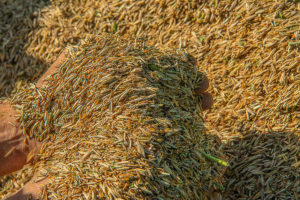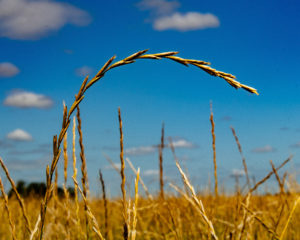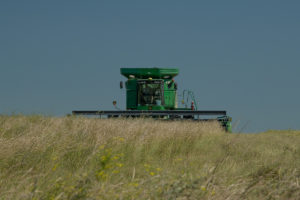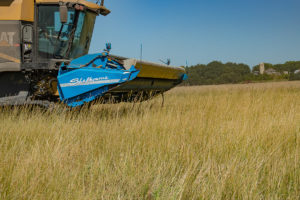Guest Post: Carmen Fernholz – A Farmer’s Perspective on Growing Kernza®
Growing Kernza® is a new venture for farmers in many ways. New crop, new rotation, and perhaps a new way to market. It has the potential to change farming, to change agriculture, to change the landscape. And we can do it with very limited alterations to our most common farming practices
As the knowledge and awareness of Kernza® grows and farmers and others find out who has been working with it and growing it, the questions begin to surface. I am one of those who has had the opportunity to work closely with the University of Minnesota as Kernza® slowly makes its way into agriculture.
Kernza® is a winter perennial that is best planted in the upper Midwest in the last few days of August or first days of September. This in itself creates a challenge for many farmers geared to a corn and soybean rotation as the harvest dates for those two crops is usually well beyond the optimum planting dates for Kernza®. Work continues to more precisely determine the latest planting date that will not inhibit yield potential.
I was first introduced to Kernza® in the summer of 2011 when Dr. Don Wyse from the University of Minnesota gave me enough seed to plant two acres. I planted the grain that September in an area on the farm that I could watch and study not realizing that it would become more than just a one-time venture.

Kernza® grows very tall, nearly six feet at full maturity. At the same time, the six to eight-inch seed head begins to ripen from the top down. So by the time the bottom third of the seed head is ripe the top third is beginning to shatter. Couple this with the fact that the kernel of grain was about an eighth the size of a regular kernel of wheat but with the seed hull still attached.
These crop characteristics create two harvesting challenges. When do I windrow it to save the highest percentage of grain? And secondly, how do I adjust the threshing mechanism inside the combine to save as much seed as possible? Added to these challenges is the fact that the Kernza® kernel is still encased in a hull much like a kernel of oats which makes it even more susceptible to threshing loss.
After several more years of research and data collecting from the harvests of the original two-acre plot, fast forward to August 2018. I planted 15 acres of the most recently developed variety from the University of Minnesota.
The variety named MN-Clearwater and officially released publicly in August of 2019 has a kernel double in size from the first grain I planted in 2011. It appears to be much less susceptible to seed head shattering as the seed head matures and ripens more evenly. And it has decreased stem lodging, a characteristic quite prevalent in earlier plant development.

The seed is still very light and fluffy resembling various types of native prairie grass. In order to assure a uniform stand with a seeding rate of approximately 12 to 15 pounds of seed per acre it works best to use and accurately calibrate a native grass seeder.
I share this experience with you because from the beginning these characteristics of shattering, seed head maturity, yield loss and lodging have been the major agronomic challenges faced by the plant scientists developing Kernza®.
When we compare Kernza® to the many other small grains that farmers are growing, general management practices are very similar. Fertility needs are about the same. I have used reasonable applications of liquid hog manure injected ahead of seed bed preparation and initial seeding of the grain and then top dress after each grain harvest. With application rates of 2000 gallons per acre, this amounts to approximately 75% first year availability of 79#’s of N, 38 #’s of P and 68#’s of K.
In an organic system it appears that weed management in Kernza® should be quite good. The concern, however, in an organic system is what row spacings should the grower use when seeding the crop. Planting in 6-inch row spacings goes a long way in suppressing weeds. However this row spacing allows for the Kernza® to become sod bound sooner, a condition that is the main cause for significant yield loss after the third growing season.

A very unique characteristic about Kernza® is the fact that it is ready to harvest when the seed head is ripe atop a grass green stem, totally different from the other small grains farmers are accustomed to growing. This characteristic poses a challenge.
Determining the best harvest date continues to be studied. We learned in 2019 that the variety we planted can go from too green to ready to harvest in a matter of 3 to 5 days. However what appears to be a good indicator of maturity is when the seed head begins to arch over much like when a regular mature wheat seed head begin to hang down instead of remaining pointed straight up (above).
Knowing this is critical because there is still a small shattering characteristic present. And of concern to organic producers is the fact that the longer a grain crop needs to stand in the field the greater the weed pressure becomes. Weeds don’t stop growing just because the grain is maturing.

The first and most common way to harvest organic Kernza® is to windrow the grain to dry out the green stems. The question arises as to how long to leave it in a swath exposing it to adverse weather conditions that can diminish the grain quality quite quickly (above). An additional downside to windrowing is the fact that the grain is exposed to another piece of equipment that can cause additional loss of grain through shattering. And finally because the grain grows so tall and in order to minimize the amount of plant material needing to go through the combine, leaving a 12 to 20-inch stubble can create a potential harvesting issue should a storm event cause the windrow to settle deep into the stubble.

A second way of harvesting is to straight cut the grain much like one would harvest other conventional grains. It is much more convenient and time saving with a single harvest pass that hopefully reduces the grain loss and exposure to unfavorable weather conditions. However, taking in green stems with ripe grain through the combine makes it challenging to harvest a good food quality grain. It is possible but requires the grain to stand for a longer period of time in the field when grain loss from seed shattering can become more pronounced.

A third method is the use of a stripper head. A stripper head operates very similar to a straight cut method (above). However the stripper head moves through the field and takes only the grain head itself leaving the rest of the plant still standing. From what I have observed, this third option appears to be the most efficient way in all aspects including significantly less exposure to adverse weather conditions, higher quality grain and minimal field loss. This method also leaves a green stem intact which can then be harvested as a forage or cut and dried for animal bedding. (I learned in 2019 that the threshing mechanism adjustments are the same whether using an older cylinder threshing mechanism or a rotary set up in newer combines.)
Which brings us to the marketability of Kernza®. Throughout its development, what has been necessary is to keep the delicate balance between supply and demand for Kernza®. Farmers need to know that the grain is a viable crop option and that there is a reliable market. Buyers need to know that there is a long-term, robust supply of a quality food grade product in order to justify investment in research and market development. Consequently discussions have begun around the idea of a farmer coop. Several people, including myself, have put together some early draft proposals which we hope to share with growers in the coming days and weeks.